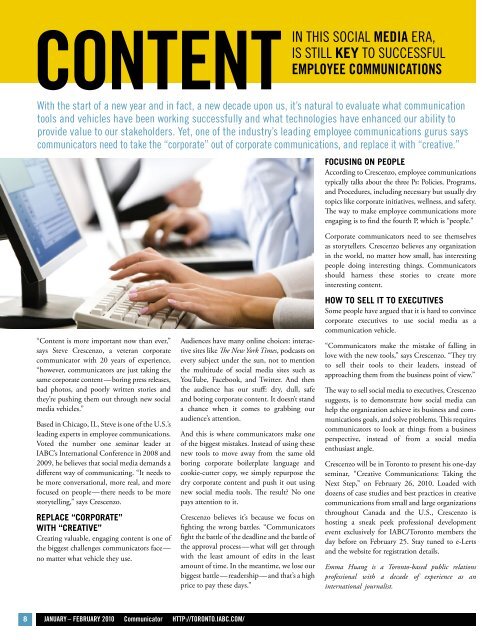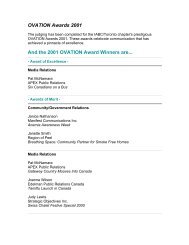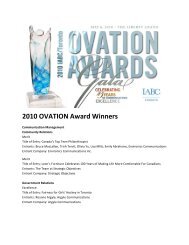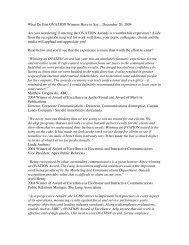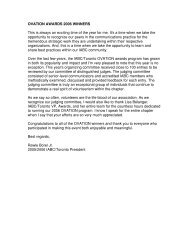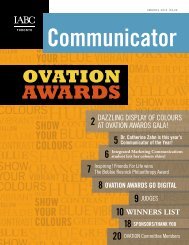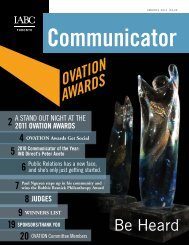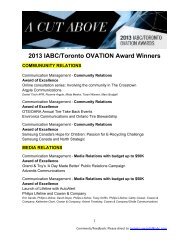Communicator
Communicator - IABC/Toronto
Communicator - IABC/Toronto
Create successful ePaper yourself
Turn your PDF publications into a flip-book with our unique Google optimized e-Paper software.
Content<br />
In this Social Media Era,<br />
is Still Key to Successful<br />
Employee Communications<br />
With the start of a new year and in fact, a new decade upon us, it’s natural to evaluate what communication<br />
tools and vehicles have been working successfully and what technologies have enhanced our ability to<br />
provide value to our stakeholders. Yet, one of the industry’s leading employee communications gurus says<br />
communicators need to take the “corporate” out of corporate communications, and replace it with “creative.”<br />
Focusing on people<br />
According to Crescenzo, employee communications<br />
typically talks about the three Ps: Policies, Programs,<br />
and Procedures, including necessary but usually dry<br />
topics like corporate initiatives, wellness, and safety.<br />
The way to make employee communications more<br />
engaging is to find the fourth P, which is “people.”<br />
Corporate communicators need to see themselves<br />
as storytellers. Crescenzo believes any organization<br />
in the world, no matter how small, has interesting<br />
people doing interesting things. <strong>Communicator</strong>s<br />
should harness these stories to create more<br />
interesting content.<br />
“Content is more important now than ever,”<br />
says Steve Crescenzo, a veteran corporate<br />
communicator with 20 years of experience,<br />
“however, communicators are just taking the<br />
same corporate content—boring press releases,<br />
bad photos, and poorly written stories and<br />
they’re pushing them out through new social<br />
media vehicles.”<br />
Based in Chicago, IL, Steve is one of the U.S.’s<br />
leading experts in employee communications.<br />
Voted the number one seminar leader at<br />
IABC’s International Conference in 2008 and<br />
2009, he believes that social media demands a<br />
different way of communicating. “It needs to<br />
be more conversational, more real, and more<br />
focused on people—there needs to be more<br />
storytelling,” says Crescenzo.<br />
Replace “corporate”<br />
with “creative”<br />
Creating valuable, engaging content is one of<br />
the biggest challenges communicators face—<br />
no matter what vehicle they use.<br />
Audiences have many online choices: interactive<br />
sites like The New York Times, podcasts on<br />
every subject under the sun, not to mention<br />
the multitude of social media sites such as<br />
YouTube, Facebook, and Twitter. And then<br />
the audience has our stuff: dry, dull, safe<br />
and boring corporate content. It doesn’t stand<br />
a chance when it comes to grabbing our<br />
audience’s attention.<br />
And this is where communicators make one<br />
of the biggest mistakes. Instead of using these<br />
new tools to move away from the same old<br />
boring corporate boilerplate language and<br />
cookie-cutter copy, we simply repurpose the<br />
dry corporate content and push it out using<br />
new social media tools. The result? No one<br />
pays attention to it.<br />
Crescenzo believes it’s because we focus on<br />
fighting the wrong battles. “<strong>Communicator</strong>s<br />
fight the battle of the deadline and the battle of<br />
the approval process—what will get through<br />
with the least amount of edits in the least<br />
amount of time. In the meantime, we lose our<br />
biggest battle—readership—and that’s a high<br />
price to pay these days.”<br />
How to sell it to executives<br />
Some people have argued that it is hard to convince<br />
corporate executives to use social media as a<br />
communication vehicle.<br />
“<strong>Communicator</strong>s make the mistake of falling in<br />
love with the new tools,” says Crescenzo. “They try<br />
to sell their tools to their leaders, instead of<br />
approaching them from the business point of view.”<br />
The way to sell social media to executives, Crescenzo<br />
suggests, is to demonstrate how social media can<br />
help the organization achieve its business and communications<br />
goals, and solve problems. This requires<br />
communicators to look at things from a business<br />
perspective, instead of from a social media<br />
enthusiast angle.<br />
Crescenzo will be in Toronto to present his one-day<br />
seminar, “Creative Communications: Taking the<br />
Next Step,” on February 26, 2010. Loaded with<br />
dozens of case studies and best practices in creative<br />
communications from small and large organizations<br />
throughout Canada and the U.S., Crescenzo is<br />
hosting a sneak peek professional development<br />
event exclusively for IABC/Toronto members the<br />
day before on February 25. Stay tuned to e-Lerts<br />
and the website for registration details.<br />
Emma Huang is a Toronto-based public relations<br />
professional with a decade of experience as an<br />
international journalist.<br />
8<br />
January – February 2010 <strong>Communicator</strong> http://toronto.iabc.com/


